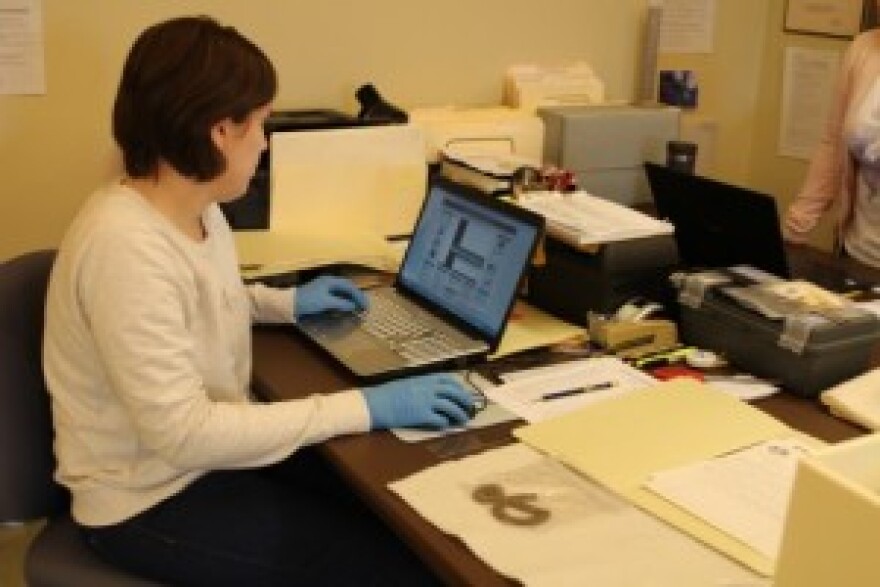The Sitka Historical Society and Museum has been acquiring objects, documents and photos for more than 50 years. And, like any collector, there comes a time to clean house.
After moving out of Harrigan Centennial Hall for its remodel this summer, the museum began refining its collection with an audit. Staffers have been cataloging hundreds of thousands of items — some that date back to the 1740s — to decide what stays and what goes.
Krystle Weddle has been combing through the museum’s collection for the past few months in its temporary home in a room at the Sealing Cove Business center. Every day the museum’s collections fellow carefully unwraps and documents the contents of boxes to record in the museum’s digital database.
Today, one of the things she’s cataloging is a metal key.
“This object looks a little bit rusty,” she said. “Considering the age of the object I would probably still give it a good rating.”
At first glance, the historical item just seems like a tchotchke – an old piece of metal shaped like an ampersand. But the museum file says it’s, “a souvenir apparently made in the Treadwell shop of some type of zinc-like metal, to be given as presents.”
Now, she has to find out if the object has any significance to Sitka.
Collections and exhibits curator Kristy Griffen says the museum started acquiring objects more than 50 years ago, before it really had a focused vision.
“People showed up and said, ‘I have this really cool whatever, here you go,'” she said.
She says the collections audit is helping to narrow the focus.
“Our mission statement is to really promote and preserve the human history of Sitka so we’re not looking at geology, we’re not looking at the natural history of this island,” Griffen said. “It’s very much the cultures, the people who have lived here and interacted for thousands of thousands of years that we are trying to hone in on.”
The museum’s collection spans from archival letters written by pioneer woman Emily McCorkle FitzGerald, who lived in Sitka with her army doctor husband in the 1870s, to a mechanical pencil.
“We don’t know where it came from we don’t know if it belonged to anybody important,” she said. “It’s just a mechanical pencil, that’s it.”
Griffen says that objects like the pencil may have to go, especially if the museum has lost track of their provenance. “And that word is just a fancy way of saying we know it’s story,” she said.
Another fancy word the museum uses is "de-accessioning." That means permanently removing an item from the collection by finding it a better home.
For example, Griffen says, the museum has some Japanese glass floats, which probably drifted up on beach, that are not extremely relevant.
“It doesn’t necessarily tell us a lot about Sitka per se, but there is actually a Japanese fishing museum in the United States,” she said.
For each item, Griffen and Weddle go through a list to decide if the item should be removed from the collection. Here’s Weddle going through the questions with the souvenir key from the Treadwell shop:
“I decide does this object really relate to Sitka or Southeast Alaska,” she said. “In this case, yes. 'Does it display well?' is also a good question.”
Another reason the museum wants to slim down its collection is to cut costs. It’s expensive to store things.
“Every square foot is costing you a ton of money up to $250 in some museums,” Griffen said. “So you better makes sure that what you have is very important to your collection.”
The audit also prepares the Sitka Historical Society and Museum for its re-opening, set for the spring of 2017. Going through all of the objects and archives is helping curator Griffen get ideas for the new exhibits she’ll be creating from scratch like maybe one of Sitka’s World War II history or another on how local artists helped shape a national perspective of Alaska. And, she says, it’s a way to update the database to get the documents and information digitized.
“More and more museums are starting, once they actually have a good, solid database going -- they are taking it online so people can just jump on from their home and look at different hings in the collection they might want to review,” Griffen said.
Further research on the souvenir Treadwell key for the database indicated the item could have an interesting provenance. The object, from the Treadwell gold Mine on Douglas Island, marks the 1908 New Year –which also happened to be an important time for owner John Treadwell. Griffen says that year Treadwell was arrested for embezzlement and forced to spend New Year’s Eve behind bars. The ordeal and subsequent trials went on for a couple years before charges against him were mysteriously dropped.
It’s those sorts of artifacts and stories that the museum wants to keep for future generations.
Harrigan Centennial Hall’s remodel should be complete by next fall and the museum will be moving in – and setting up – its new exhibits as soon as construction is done.


